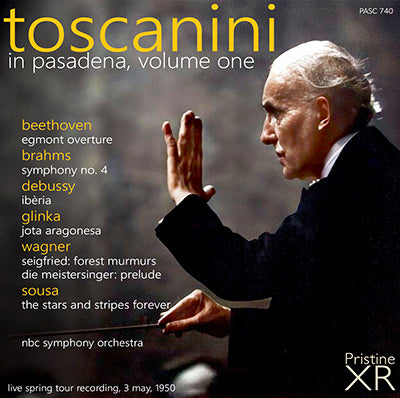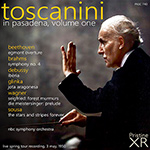
This album is included in the following sets:
This set contains the following albums:
- Producer's Note
- Full Track Listing
- Cover Art
- NY Times Review
Toscanini took the NBC Symphony Orchestra on two lengthy tours during his time with the orchestra. In June and July 1940 they travelled to South America, giving a total of fifteen concerts in Rio de Janeiro, São Paolo, Buenos Aires and Montevideo.
Ten years later, in April and May of 1950, Toscanini and the NBC orchestra ventured out on their only US tour, playing a total of 22 concerts across the country. Only in Pasadena, California, did the tour take a short travel stop to play two consecutive concerts at the same venue, on Wednesday 3rd and Friday 5th May, before continuing nearly 400 miles north to San Francisco, then proceeding north to Portland, Oregon and Seattle, Washington before slowly heading back east.
The logistics of the tour do sound quite something. The bulk of the orchestra, with its instruments, travelled on a specially-commissioned 15-carriage train which was pulled around the country by diesel-engined locomotives. This special train served as accommodation for the orchestra, as well as an entertainment venue for post-concert parties when not in motion. Not everyone took the train, of course, and newspaper records of the day related airport incidents as the main stars arrived by plane at their destinations – no doubt a far more convenient way to travel than the lengthy journeys by rail.
It seems little audio record survives of the actual concerts, and I’m not sure whether any surviving recordings have ever been widely heard. An encore of “Dixie” from one of the concerts is known to circulate amongst collectors and may appear in the second of two volumes in this set as a bonus track.
But happily two concerts were recorded, and in very good sound, onto acetate discs. Acetate discs, which deteriorate rapidly after their first play, were certainly not expected to survive for seventy-five years, and it is therefore quite astonishing to be able to restore these fragile recordings back to life. The first half of the present concert, comprising the Beethoven and Brahms, was by far the more damaged of the two, though restoration work has made a massive difference to the listening experience here, and only in a handful of quieter sections might the listener pick up on residual surface noise that has proved impossible to entirely eliminate. By contrast, the second disc, from the Debussy onwards, proved generally a much better-preserved set, the sides remaining remarkable clean and quiet for most of the second half of the concert.
It is not clear how these recordings came to be made and for what purpose. There is no broadcast commentary to suggest any radio transmissions, and the concerts are thus presented here as heard on the night, with just a modicum of editing where applause was lengthy (and very enthusiastic) – it’s my personal opinion that little is to be gained today by hearing all of the two minutes and nine seconds of rapturous applause needed to bring Toscanini back for the evening's encore!
The second Pasadena concert has been similarly preserved, and will appear at Pristine later this year, featuring music by Beethoven, Rossini, Smetana, Tchaikovsky and Wagner, with no music repeated from the first concert. But for now, let’s go back some 75 years in time to that first Pasadena concert, with its star-studded audience, and relive a world where Bob Hope would wait for ten minutes outside the main star's dressing-room door – to catch a moment or two with Arturo Toscanini in Pasadena...
Andrew Rose
Toscanini in Pasadena, Volume 1
disc one (48:00)
1. BEETHOVEN Egmont Overture, Op. 84 (9:39)
BRAHMS Symphony No. 4 in E minor, Op. 98
2. 1st mvt. - Allegro non troppo (11:28)
3. 2nd mvt. - Andante moderato (10:36)
4. 3rd mvt. - Allegro giocoso (6:17)
5. 4th mvt. - Allegro energico e passionato (10:00)
disc two (51:08)
DEBUSSY Images pour orchestre: 2. Ibèria
1. I. Par les rues et les chemins (7:26)
2. II. Les parfums de la nuit (6:45)
3. III. Le matin d'un jour de fête (5:03)
4. GLINKA Jota Aragonesa (8:43)
5. WAGNER Siegfried - Forest Murmurs (9:11)
6. WAGNER Die Meistersinger von Nürnberg - Prelude (9:13)
7. SOUSA The Stars and Stripes Forever (encore) (4:46)
NBC Symphony Orchestra
conducted by Arturo Toscanini
XR remastering by Andrew Rose
Cover artwork based on a photograph of Toscanini
Live concert recording, 3 May 1950, Pasadena Civic Auditorium
Total duration: 1hr 39:08
FULL POMP GREETS TOSCANINI ON COAST
Glitter Marks Maestro’s First Program in Pasadena— 3,000 Attend Concert
By HOWARD TAUBMAN
PASADENA, Calif., May 3 — Arturo Toscanini and his touring N.B.C. Symphony Orchestra gave the first of two concerts in this city's Civic Auditorium tonight. The hall, which seats 3,000, had been sold out for weeks for both concerts, and there are thousands in the Los Angeles area who are disappointed that they cannot see and hear the 83-year-old maestro make music in person.
R. C. A., sponsoring the tour, had hoped to give at least one concert in the Shrine Auditorium in Los Angeles, which can accommodate 6,000, but the hall was committed this week for another series of events.
Tonight's audience was the most glittering of the tour thus far. Leading citizens of the Los Angeles area, including some of the most glamorous names in Hollywood, turned out in all their finery. This was a full-dress occasion, like opening night at the Metropolitan in New York.
At Top of His Form
Mr. Toscanini, who has been in rare form on this trip, was at the top of it tonight. He was apparently undisturbed by the altercation that had occurred at the airport upon his arrival by plane from Dallas yesterday. His son, Walter, who had tangled momentarily with a photographer from The Los Angeles Examiner because the latter had shot off a flash bulb near the maestro, was unharmed from the glancing blow struck by the camera which the photographer had swung at him.
The maestro, who has been through several incidents with photographers shooting flash bulbs over the years, took a calm view of the incident. It was learned today that when he and Walter got into their car upon leaving the airport Mr. Toscanini had told his son that he had done right to fend off the photographer.
He conducted tonight with his accustomed concentration, as though there was nothing on his mind but the most complete projection of the innermost meaning of the music. And that, of course, was the only thing on his mind at the moment.
Brahms on Program
Tonight's program had the Brahms Fourth symphony as the big work, with Beethoven's “Egmont" overture, Debussy's “Iberia,” Glinka’s “Jota Aragonesa” and two Wagner excerpts—Waldweben from “Siegfried” and the “Meistersinger” prelude—rounding out a full evening.
The special train carrying the bulk of the orchestra arrived in Pasadena at 1:30 this afternoon, although a few of the instrumentalists had flown from Dallas to Los Angeles on their own yesterday. The train-riding orchestra brought word that there had been a bad moment en route. A diesel engine had run into trouble outside of New Clovis, N. M., and there was a half-hour delay while another engine was brought up.
Mr. Toscanini gave his players several hours to get settled in their hotels. At 5 P. M. they were in their places on the stage of the Civic Auditorium, where he conducted a brief rehearsal to try the acoustics.
The New York Times, May 4, 1950

